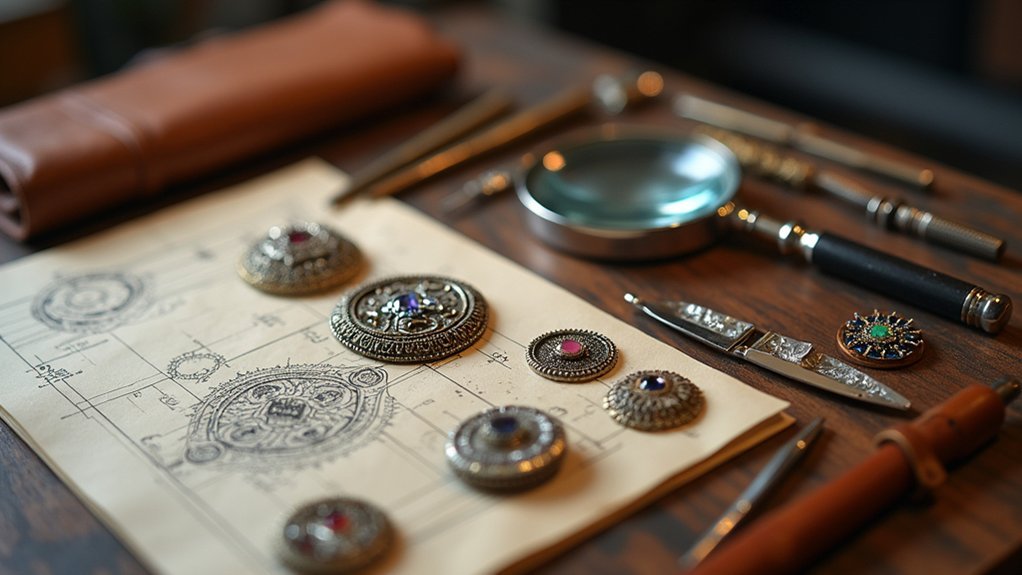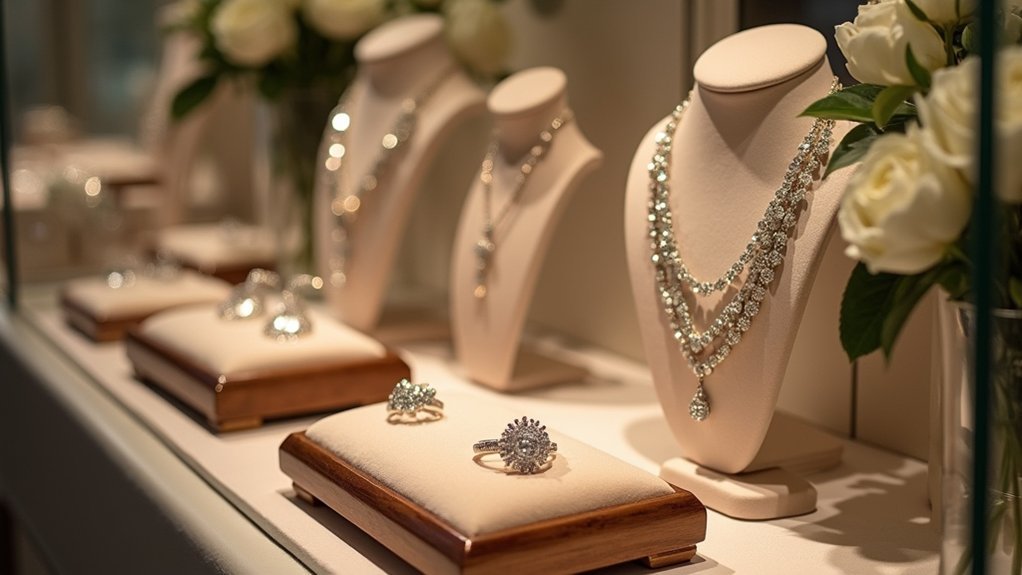You’re about to make a jewelry purchase, but have you considered where those precious metals and gemstones actually come from? The sparkle of your diamond or the gleam of your gold might hide a darker story of environmental destruction and worker exploitation. Before you invest in that special piece, there are seven critical ethical sourcing factors that’ll transform how you view every jewelry decision moving forward.
Understanding the Origins of Precious Metals and Gemstones

When you purchase jewelry, you’re often unaware that the precious metals and gemstones adorning your pieces may have traveled through complex global supply chains fraught with ethical concerns.
Understanding ethical sourcing becomes vital when you consider that artisanal mining employs over 100 million people worldwide, often under unsafe conditions.
These precious metals and gemstones frequently originate from developing countries where workers face exploitation despite their essential role in extraction processes.
The environmental impact includes deforestation and soil degradation that devastates local ecosystems.
Without fair wages and proper working conditions, miners struggle while their labor creates luxury items.
Evaluating Labor Practices and Fair Working Conditions
Although you’ve learned about the origins of precious metals and gemstones, you must now examine the human cost behind these materials by evaluating labor practices throughout the jewelry supply chain.
Ethical sourcing demands you scrutinize fair working conditions and guarantee responsible sourcing practices. When you prioritize transparency, you’ll uncover disturbing realities about artisanal mining communities worldwide.
Consider these alarming facts:
- Over 100 million workers face exploitation in unsafe jewelry industry conditions.
- One million children risk their health in dangerous mining environments.
- Child labor and trafficking plague communities dependent on mining income.
- Forced labor traps vulnerable workers in artisanal mining operations.
You must demand fair wages and safe environments from suppliers.
Certifications like Fairmined Gold and standards from the Responsible Jewelry Council help verify ethical labor practices throughout your supply chain.
Assessing Environmental Impact of Mining Operations

When you’re evaluating jewelry suppliers, you’ll need to examine how their mining operations affect local environments.
The extraction process often causes massive deforestation—producing just one wedding ring can destroy 20 tons of earth and eliminate essential wildlife habitats.
You should also investigate water contamination risks, as mining practices like cyanidation for gold extraction can poison local water sources and devastate surrounding ecosystems.
Deforestation and Habitat Loss
Behind every sparkling ring lies a devastating environmental cost that’s often hidden from consumers’ view.
Mining operations devastate ecosystems through massive deforestation and habitat loss, creating environmental harm that extends far beyond the extraction site. You’re supporting an industry where a single wedding band requires removing 20 tons of earth, while mineral mining destroyed 4,500 square miles of Amazon rainforest between 2005-2015.
Consider these devastating impacts:
- Toxic chemicals like cyanide and mercury poison water sources your family depends on.
- Displaced wildlife lose their homes forever as habitats fragment and disappear.
- Local communities suffer as traditional livelihoods vanish with destroyed natural resources.
- Global climate suffers as carbon-storing forests disappear permanently.
You can choose ethical sourcing and sustainable practices that protect both nature and local communities.
Water Contamination Risks
How can a single gold ring poison entire communities for generations? When you purchase jewelry without considering ethical sourcing, you’re potentially supporting operations that devastate water systems through toxic chemicals like mercury and cyanide.
These contaminants don’t disappear—they persist, creating contaminated water that causes neurological disorders and respiratory problems in small-scale mining communities.
Diamond mining and gold extraction contribute roughly 20% of global mercury emissions, poisoning rivers and destroying aquatic ecosystems.
In places like Zamfara, Nigeria, improper mining has caused widespread mercury poisoning, affecting both human health and agricultural productivity.
You can break this cycle by demanding sustainable practices from jewelers. Choose suppliers who prioritize human rights and environmental protection, ensuring your beautiful jewelry doesn’t come at the cost of water pollution and community suffering.
Identifying Certified Ethical Jewelry Materials and Suppliers
While the jewelry industry has historically faced scrutiny over unethical practices, identifying certified ethical jewelry materials and suppliers has become significantly more accessible through established certification programs.
You can now confidently source certified ethical jewelry materials through several trusted pathways. Fairtrade Gold and Fairmined Gold guarantee that artisanal miners receive fair wages and work under safe conditions.
The Responsible Jewelry Council certifies brands demonstrating thorough ethical sourcing practices throughout their supply chains. Additionally, conflict-free diamonds verified through the Kimberley Process ensure your purchases don’t fund violence, while recycled metals reduce environmental impact.
Consider these certification standards when selecting suppliers:
- Fairtrade/Fairmined certification – Supporting mining communities directly
- RJC membership – Ensuring thorough supply chain responsibility
- Kimberley Process compliance – Guaranteeing conflict-free diamond origins
- Recycled material verification – Reducing new mining demands
Exploring Recycled and Lab-Grown Alternatives

Beyond sourcing certified materials from traditional suppliers, recycled diamonds and lab-grown alternatives offer compelling pathways to reduce your jewelry’s environmental impact.
Recycled diamonds from previously owned jewelry greatly minimize mining demands while avoiding conflict diamonds. Since approximately 30% of diamonds originate from Russian mines, choosing recycled options guarantees responsible sourcing.
Lab-grown diamonds provide conflict-free alternatives, though you should evaluate energy consumption claims critically. The FTC has warned against misleading sustainability assertions, so you’ll want to verify environmental benefits carefully.
For sustainable practices, consider recycled gold, which comprises 28% of gold supply and reduces new mining demands.
Fairmined certifications guarantee artisanal gold meets ethical sourcing standards, supporting your commitment to responsible jewelry choices.
Verifying Brand Transparency and Supply Chain Traceability
You’ll need to examine certification standards like those from the Responsible Jewellery Council (RJC) when evaluating a jewelry brand’s ethical commitments.
Look for brands that provide detailed supply chain documentation, including reports or website sections that trace their materials from source to sale.
These transparency measures help you verify whether the company truly follows responsible sourcing practices or simply makes empty claims.
Certification Standards Review
When you’re evaluating jewelry brands for ethical sourcing, certification standards serve as your most reliable guide for verifying genuine transparency and supply chain accountability.
These rigorous frameworks guarantee the jewelry industry adheres to responsible sourcing practices while promoting sustainable practices throughout production.
Key certification standards that build consumer trust include:
- Fairmined Gold – Guarantees miners receive fair wages while protecting their communities from exploitation.
- Responsible Jewellery Council (RJC) – Enforces extensive ethical, social, and environmental guidelines across operations.
- Fairtrade certification – Requires complete traceability documentation proving materials weren’t sourced through harmful practices.
- Kimberley Process – Prevents conflict diamonds from reaching consumers, though critics highlight remaining worker protection gaps.
You’ll find certified brands must undergo third-party audits, providing verifiable proof of their ethical commitments beyond marketing claims.
Supply Chain Documentation
While certification standards provide the foundation for ethical sourcing, supply chain documentation serves as the detailed roadmap that proves a brand’s commitment to transparency.
You’ll find that robust traceability systems allow you to track gemstones and precious metals from their origins to the final product, helping prevent conflict diamonds from entering the market.
When evaluating jewelry brands, you should look for thorough supplier disclosure and collaboration with organizations like the Responsible Jewelry Council.
These partnerships demonstrate responsible practices and enhance accountability throughout the supply chain.
However, you must understand that regulatory frameworks face ongoing challenges in fully addressing worker exploitation and environmental concerns.
Effective transparency policies enable you to make informed purchasing decisions based on verified ethical sourcing standards.
Aligning Personal Values With Jewelry Investment Decisions

Making jewelry purchases that reflect your personal values requires a deliberate shift from focusing solely on aesthetics and price to contemplating the ethical implications of your investment decisions.
Ethical sourcing guarantees materials are obtained responsibly, protecting both people and environments throughout supply chains.
Consider these emotionally resonant approaches:
- Support certified brands – Choose Fairtrade or Responsible Jewelry Council certified companies that prioritize worker welfare.
- Select sustainable materials – Invest in jewelry made from recycled metals or lab-grown diamonds to minimize environmental impact.
- Demand transparency – Research gemstone and metal origins to avoid contributing to exploitation or conflict.
- Amplify positive impact – Partner with brands donating profits to social causes, creating ethically sourced pieces that generate meaningful change.
Frequently Asked Questions
What Is Ethically Sourced Jewelry?
You’ll find ethically sourced jewelry uses materials obtained through responsible practices, ensuring fair labor conditions and minimal environmental impact. It features conflict-free diamonds and promotes transparency throughout the entire supply chain process.
What Is an Example of Ethical Sourcing?
You’ll find Fairmined Gold certification as a prime example. It guarantees your gold comes from responsible small-scale miners who follow strict social and environmental standards, ensuring ethical practices throughout production.
What Is Ethical Sourcing Gemstones?
You’re ensuring gemstones are obtained through responsible practices that prioritize fair labor conditions, environmental protection, and community benefits. You’re supporting mining operations that don’t exploit workers or harm ecosystems.
Can Gold Be Ethically Sourced?
You can ethically source gold through Fairmined certification, recycled materials, and Responsible Jewellery Council standards. These guarantee fair labor practices, eliminate toxic chemicals, and support sustainable mining in artisanal communities worldwide.
In Summary
You’ve now explored the essential elements of ethical jewelry sourcing, from understanding material origins to verifying supply chain transparency. Armed with this knowledge, you can confidently evaluate jewelers and make purchases that reflect your values. Don’t hesitate to ask detailed questions about sourcing practices and certifications. Your informed choices will support sustainable mining practices, fair labor conditions, and environmental responsibility while ensuring your jewelry investment aligns with your ethical standards.





Leave a Reply